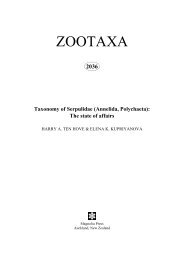You also want an ePaper? Increase the reach of your titles
YUMPU automatically turns print PDFs into web optimized ePapers that Google loves.
or dense tomentum; basal pinna 13.1(7.0–17.7) cm long, 3.1(1.6–4.7) cm wide; cirri well-developed, with<br />
acanthophylls, with few spines abaxially, mostly on proximal part only, with no intermediate acanthophylls<br />
present, usually with a wide gap between pinnae and acanthophylls (i.e., gap wider than that between adjacent<br />
acanthophylls). Inflorescences with the rachis angular, slightly twisted, thicker than the few, closely spaced<br />
and spirally arranged rachillae, each rachilla not (or very rarely) adnate to the rachis, subtended by an acute<br />
bracteole and with a well-developed axillary pulvinus; peduncles 2.0(1.0–3.0) mm wide; peduncular bracts<br />
18.8(16.0–24.5) cm long, broad, ribbed, densely brown tomentose, without spines (very rarely with a few<br />
spines); rachillae 5(4–9), glabrous or scarcely tomentose initially; basal rachilla 5.1(3.5–6.8) cm long,<br />
1.5(1.0–2.3) mm wide; stamens 6; fruits 20.9(18.4–23.9) mm long, 13.3(11.1–15.3) mm wide, the surfaces<br />
uneven with numerous, subepidermal, long, branching fibers; fruiting corollas less than one quarter as long as<br />
fruits, splitting irregularly into 3 lobes, the lobes often splitting again; endocarps globose to obovoid with<br />
rounded or slightly peaked apices, the pores lateral.<br />
Distribution and habitat:—From 1°20’–4°31’S and 69°56’–76°25’W in the western Amazon region in<br />
Colombia, Peru, and Brazil at 174(112–550) m elevation in lowland rainforest, often on sandy soils (Fig. 12).<br />
Taxonomic notes:—This distinctive species, with its small leaves and large fruits, was referred to by<br />
Henderson (1995) as Desmoncus polyacanthos var. prunifer (Poeppig ex Martius) Henderson, based on D.<br />
prunifer Poeppig ex Martius. This is a mistake, as explained under D. prunifer.<br />
Undescribed species<br />
Four specimens from the same locality on eastern Andean slopes in Ecuador are unusual in their straight leaf<br />
spines, narrow pinnae with long, filiform apices and with an adaxial beard of spines at the bases, and high<br />
elevation habitat (700–1350 m). They are all sterile but appear to represent an undescribed species.<br />
ECUADOR. Napo: Hollin-Loreto road to Coca 11 km from take-off from Baeza-Tena road, 1350 m,<br />
0°42’S 77°43’W, 1 Oct 1995, Balslev et al. 6424 (AAU); Santa Rita west of Archidona, 800–1130 m, 0°55’S<br />
77°52’W, 12 Aug 1996, Balslev et al. 6447 (AAU); Llanganates, ca. 700 m, 23 Nov 2010, Cornejo et al. 8398<br />
(NY); km 2, carretera nueva Cotundo-Coca, 1130 m, 5 Aug 1984, Dodson et al. 15042 (MO).<br />
Acknowledgements<br />
I thank the many people who have helped with this work. The staff of the herbarium of the New York<br />
Botanical Garden processed the many loans I requested, particularly Dr. Tom Zanoni, Lucy Klebieko, and<br />
Wilson Ramos. Dr. Holly Porter Morgan and Hannah Stevens of the GIS Laboratory provided expertise on<br />
map making; Michael Bevans of the Herbarium Digitization Laboratory provided the type images; Dr. Scott<br />
Mori helped with photography; and Xavier Cornejo helped with information on Ecuadorean specimens. The<br />
curators of the following herbaria sent these loans, or allowed me to study specimens in their care: A, AAU,<br />
BH, BM, CEN, COAH, COL, CR, F, GH, HEPH, IBGE, INB, INPA, K, M, MG, MICH, MO, NY, P, PMA, R,<br />
S, SPF, UB, and US. I thank Drs. Nelson Zamora and Barry Hammel in Costa Rica; Dr Mireya Correa and<br />
Carmen Galdames in Panama; Paula Leitman in Rio de Janeiro, Drs. José Pirani and Renata Pardini in São<br />
Paulo, Dr. Aldicir Scariot and Renata Martins in Brasília, and Drs. Michael Hopkins and Alberto Vincentini in<br />
Manaus. Dr. Rodrigo Bernal wrote the Latin diagnoses.<br />
References<br />
Bailey, L. (1933) Certain palms of Panama. Gentes Herbarum 3: 31–116.<br />
Bailey, L. (1943) New palms in Panama, and others. Gentes Herbarum 6: 198–264.<br />
A REVISION OF DESMONCUS (ARECACEAE)<br />
Phytotaxa 35 © 2011 <strong>Magnolia</strong> <strong>Press</strong> 47
















